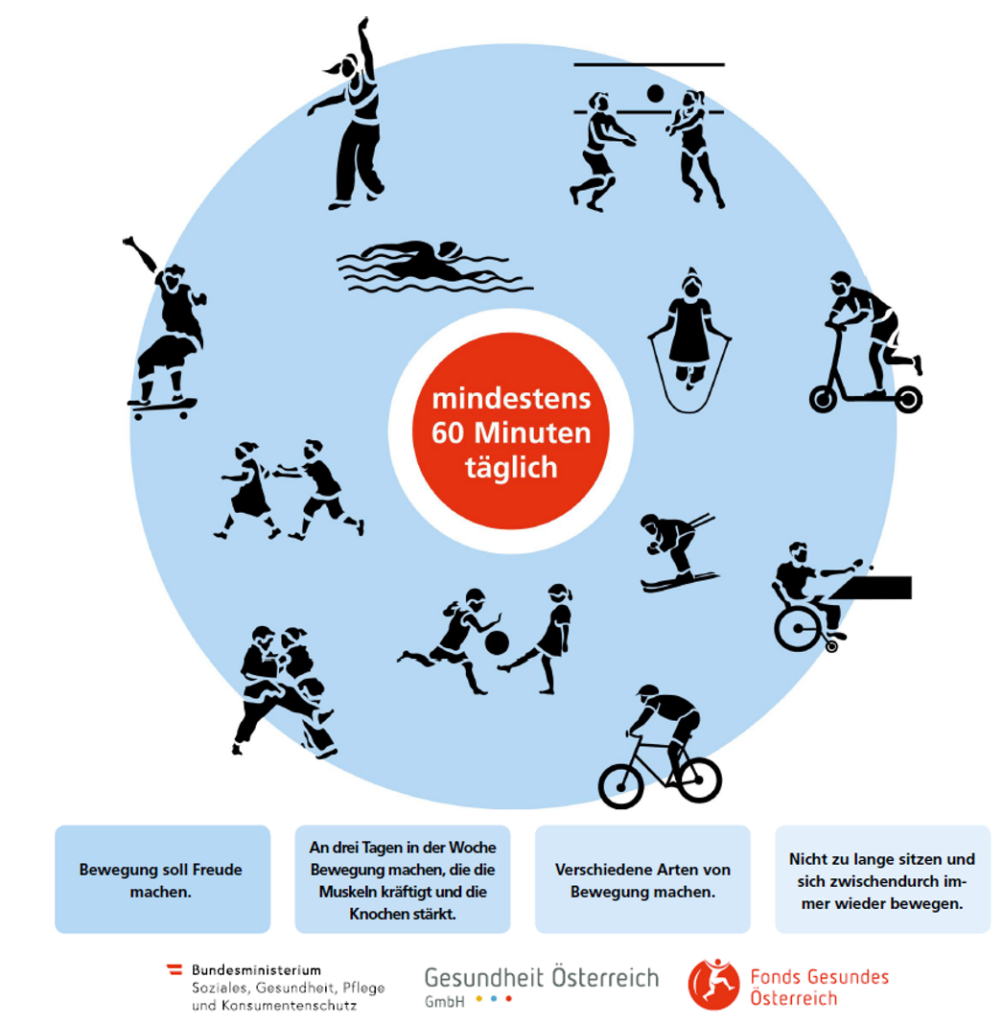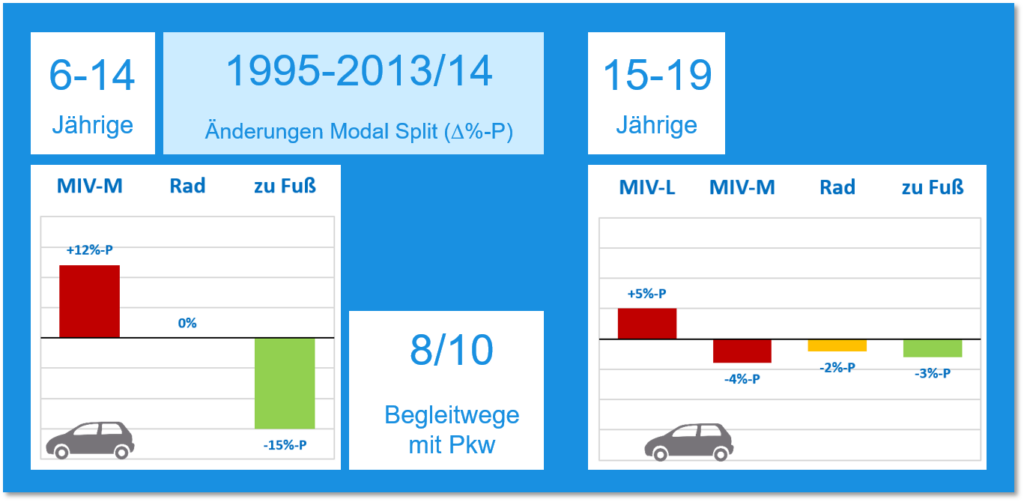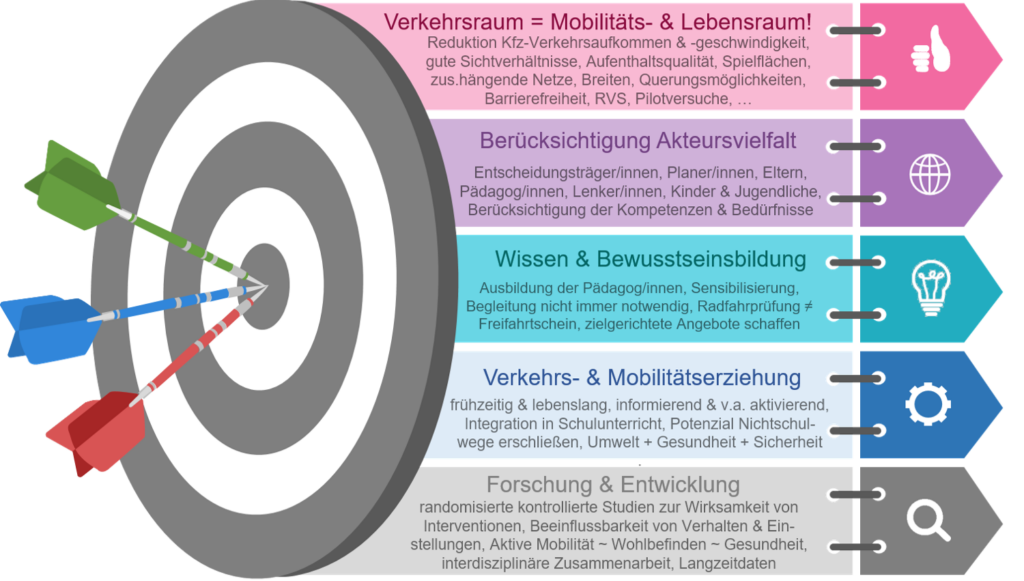
The promotion of active, independent, safe mobility for children and young people is an important concern and field of research at the Institute of Transport Studies at the University of Natural Resources and Life Sciences, Vienna. The YOUNG MOBILITY platform presents projects, campaigns and student work on child and youth mobility at the Institute of Transport Studies.
Young age groups at the center of transport research
Juliane Stark, 03/2024
Children and young people are a relevant age group in transport behavior research for several reasons. A key aspect that underlines the special nature of this group are recent observable trends in the area of mobility, physical activity and health behavior, which represent an unsustainable development and indicate a need for action: Trends show continuously decreasing rates of physical activity (PA) among children and adolescents (e.g. WHO 2018). In Austria, for example, only 17% of pupils meet the World Health Organization (WHO) recommendations for physical activity in children (Maier et al., 2017; Ramelow et al., 2015).

Falling PA levels are associated with negative health consequences, e.g. rising rates of obesity (e.g. Pucher et al., 2010; Lobstein et al., 2004). In a study from 2016, 65% of young people between the ages of 14 and 29 reported having physical complaints (Knechtsberger & Schwabl, 2016). In line with these developments, declining rates of active forms of mobility (walking, cycling) can also be observed in the everyday lives of children and young people in Austria (Tomschy et al., 2016).

To make matters worse, children’s independent mobility also appears to be declining (e.g. Shaw et al., 2013; Frauendienst & Redecker, 2011). These tendencies of inactivity in children can also have consequences for their road participation and road safety when they are adults. For example, because their psychomotor skills are not well trained, which can lead to difficulties when cycling (Meschik et al., 2017). Children are per se a vulnerable group in road traffic for many reasons. Among other things, their small size and not (fully) developed traffic skills (Schützhofer et al., 2015) play a role here. In Austria, road traffic is one of the main causes of death in the 15 to 24 age group; young motorcyclists in particular are among the groups with the highest accident rates (Statistik Austria, 2011). Overall, there is still great potential when it comes to designing a child-friendly traffic and mobility system. The latter means not only creating infrastructure that promotes safe walking, scooting and cycling, but also seeing the traffic area as a place to stay and play – as a living space.

The topics described clearly show how important it is to promote active forms of mobility for this age group. Efficient interventions are needed that aim to shape attitudes and mobility behavior at an early stage in terms of sustainable transport development and counteract the later development of car-oriented lifestyles. This can only succeed if decision-makers, planners, educators and parents pull together. Parents in particular are a key factor, as children’s mobility behavior is not (only) an expression of their own decisions, but the result of complex household decisions. Stakeholders need to develop an understanding that integrating active forms of mobility into children’s everyday mobility can contribute to their well-being and quality of life (e.g. Friman et al., 2018; Waygood et al., 2017 & 2018; Stark et al., 2018c) and that child-friendly transportation spaces benefit everyone.
Even if some determinants of mobility behavior are known, there is a need for further research when it comes to influencing the mobility behavior and mobility-related attitudes of young people. This also highlights methodological aspects that make research on children and young people in the context of mobility and transport a particular challenge.
References
Frauendienst, Björn., and Andreas P. Redecker. 2011. Die Veränderung der selbstständigen Mobilität von Kindern zwischen 1990 und 2010. [Changes of children‘s independent mobility between 1990 and 2010.] Zeitschrift für Verkehrssicherheit, 57(4), 187-190.
Friman, Margareta, Westman, Jessica, and Lars E. Olsson. 2018. Children’s Life Satisfaction and Satisfaction with School Travel. Child Indicators Research. doi:10.1007/s12187-018-9584-x.
Fonds Gesundes Österreich (Hrsg.) (2020): Österreichische Bewegungsempfehlungen, Band Nr. 17 aus der Reihe WISSEN.
Knechtsberger, A., & Schwabl, T. (2016). Jugend-Trend-Monitor 2016. Präsentation am 14.04.2016.
Lobstein, Tim, Baur, Louise A., and Ricardo Uauy. 2004. Obesity in children and young people: a crisis in public health. The International Association for the Study of Obesity. obesity reviews 5 (Suppl. 1), 4–85.
Maier, Gunter, Friedrich Teutsch, and Rosemarie Felder-Puig. 2017. HBSC Factsheet 01 – Das Bewegungsverhalten österreichischer Schülerinnen und Schüler: HBSC Ergebnisse 2014. [HBSC Factsheet 01 – Physical activity behaviour of Austrian pupils: HBSC results 2014.] Federal Ministry for Health and Women (Ed.). Accessed July 27 2018. https://www.bmgf.gv.at/home/Gesundheit/Kinder_und_Jugendgesundheit/
Schulgesundheit/Gesundheit_und_Gesundheitsverhalten_oesterreichischer_SchuelerInnen.
McDonald, N.C. (2008). Household interactions and children’s school travel: the effect of parental work patterns on walking and biking to school. Journal of Transport Geography, 16(5), 324-331. doi:http://dx.doi.org/10.1016/j.jtrangeo.2008.01.002.
Meschik, M., Stark, J., & Kalteis, B. (2017). Children´s cycling skills and the impact of physical activity. Paper presented at International Cycling Conference 2017, SEP 19-21, 2017, Mannheim, GERMANY.
Pucher, J., Buehler, R., Bassett, D.R., & Dannenberg, A.L. (2010). Walking and Cycling to Health: A Comparative Analysis of City, State, and International Data. American Journal of Public Health, 100(10), 1986-1992. doi:10.2105/Ajph.2009.189324.
Ramelow, D., Teutsch, F., Hofmann, F., & Felder-Puig, R. (2015). Gesundheit und Gesundheitsverhalten von österreichischen Schülern und Schülerinnen; Ergebnisse des WHO-HBSC-Survey 2014. [Health and health-related beahviour of Austrian pupils – Results of WHO-HBSC-survey 2014.] Austrian Federal Ministry of Health (Ed.), Vienna.
Schützhofer, B., Rauch, J., Knessl, G., & Uhr, A. (2015). Neue Ansätze in der verkehrspsychologischen Verkehrssicherheitsarbeit im Kindesalter. [New traffic psychologically-based methods in traffic safety work for children.] Zeitschrift für Verkehrssicherheit, 4/2015, 12.
Shaw, B., Watson, B., Frauendienst, B., Redecker, A., Jones, T., & Hillman, M. (2013). Children’s independent mobility: a comparative study in England and Germany (1971-2010). London: Policy Studies Institute.
Statistik Austria: Straßenverkehrsunfälle (2011) [Road accidents.]. Retrieved from: http://www.statistik.at/web_de/presse/063400.html (last accessed August 11th 2018).
Stark, J., Beyer Bartana, I., Fritz, A., Unbehaun, W., & Hössinger, R. (2018a).The influence of external factors on children’s travel mode: A comparison of school trips and non-school trips. Journal of Transport Geography, 68, 55-66. doi:https://doi.org/10.1016/j.jtrangeo.2018.02.012.
Stark, J., Frühwirth, J., & Aschauer, F. (2018b). Exploring independent and active mobility in primary school children in Vienna. Journal of Transport Geography, 68, 31-41. doi:https://doi.org/10.1016/j.jtrangeo.2018.02.007.
Stark, J., Meschik, M., Singleton, P. A., & Schützhofer, B. (2018c). Active school travel, attitudes and psychological well-being of children. Transportation Research Part F: Traffic Psychology and Behaviour, 56, 453-465. doi:https://doi.org/10.1016/j.trf.2018.05.007.
Stark, J., Uhlmann, T., Fanninger, C., Schützhofer, B., Berger, W. J., & Kirchner, M. (2018d). Seeing the world through the eyes of a child – A smartphone application to visualize children’s perceptions of their transport geographies. Poster presented at the 9th Child in the City World Conference, 24 – 26 September 2018Vienna, Austria, Vienna, Austria.
Stark, J (2021): Eckpunkte eines kindgerechten Verkehrssystems. Was braucht es, damit Kinder selbständig zu Fuß und mit dem Fahrrad mobil sein können?. VCÖ-Fachveranstaltung: Kindgerechtes Verkehrssystem – Mehr Platz für bewegungsaktive Mobilität, MAR 26, 2021, Online
Tomschy, R., Herry, M., Sammer, G., Klementschitz, R., Riegler, S., Follmer, R., Gruschwitz, D., Josef, F., Gensasz, S., & Kirnbauer, R. (2016). Österreich unterwegs 2013/2014. Ergebnisbericht zur österreichweiten Mobilitätserhebung. [Results of the Austrian-wide household travel survey.] Vienna: Federal Ministry for Transport, Innovation and Technology.
Tomschy, R., Steinacher, I., and F. Matiasek. Österreich unterwegs … mit dem Fahrrad. Radverkehrsergebnisse der Mobilitätserhebung „Österreich unterwegs 2013/2014“ des bmvit. Wien: Bundesministerium für Verkehr, Innovation und Technologie: Gesamtverkehr; Datenbasis: bmvit „Österreich unterwegs 2013/2014“, 2017.
Waygood, E.O.D., Friman, M., Olsson, L.E., & Taniguchi, A. (2017). Transport and child well-being: An integrative review. Travel Behaviour and Society. doi:https://doi.org/10.1016/j.tbs.2017.04.005.
Waygood, E. O. D., Friman, M., Taniguchi, A., & Olsson, L. E. (2018). Children’s life satisfaction and travel satisfaction: Evidence from Canada, Japan, and Sweden. Travel Behaviour and Society. doi:https://doi.org/10.1016/j.tbs.2018.04.004
WHO (2018). Global action plan on physical activity 2018–2030: More active people for a healthier world, ISBN 978-92-4-151418-7.
